To the men out there, bench press isn't everything. Try these, especially the last item
Courtesy from ACE PRoSource
A few weeks ago I saw one of the most entertaining scenes ever in my 20-plus years of belonging to and working in health clubs. It was early on a Saturday morning and I was doing a TRX workout. There was a group of about four or five guys in the free-weights area having a bench-press contest. Guys challenging each other to see who can lift the most is nothing new, but what made this group stand out was the fact that they looked to be in their late 50s or early 60s. The most entertaining part is that these guys were talking serious smack—if it wasn't for the gray hair and bifocals they could've been mistaken for a group of high school football players.
I've been thinking about that scene and wondering how often it is played out in gyms and health clubs around the country. In my experience, most guys learn to lift while playing sports in high school or college and one of the most popular exercises is the bench press. Now, I have to admit that I used to live and die by how much I could bench (365 lbs. was my max) but I am now in a 12-step recovery program for bench press and it has been almost seven years since my last barbell bench press.
Not really. And not to make light of addiction issues, but it seems as if many men who work out make the bench press a focal point of their exercise program because it is what they learned during their athletic careers. If benching a certain amount of weight can help you earn more playing time on your high school team, then by all means, focus on the bench press. But for guys who are juggling a career, family and social obligations, time can be extremely valuable. And while the bench press might be a popular exercise it only engages a few muscles and has very little practical use in day-to-day life.
Furthermore, an exercise program that is too chest dominant can create a muscle imbalance that could be responsible for a rotator cuff injury that limits the function of the shoulder. The distal attachment of the pectoralis major creates internal rotation of the humerus (upper arm bone), while the proximal attachment along the clavicle can pull the scapula into protraction. When both occur simultaneously it can create an impingement of the supraspinatus muscle of the rotator cuff responsible for stabilizing the shoulder. In addition, bringing a load directly down on the chest while the scapulae are being held in place by a bench puts a tremendous amount of force on the anterior capsule of the shoulder. Sitting at a computer for hours a day without the best posture can already place your shoulder and chest muscles in a shortened, weakened position that greatly enhances the risk of injury. The chances are that if you work out regularly, you may know someone who has injured his shoulder while benching—now you know why.
Except for competitive powerlifters, the amount of weight a man can bench press is irrelevant to improving his quality of life as he ages. If you only have a limited amount of time, the best way to get results is to make exercise as efficient and effective as possible, using movements that involve a number of muscles simultaneously. The body burns 5 calories to consume 1 liter of oxygen; therefore, the more muscles used during a workout, the more oxygen used and the more calories are expended. The following exercises can help increase lean muscle mass, improve definition and burn calories, and should be a part of every guy's exercise program.
Squat or Deadlift

The only difference between these two exercises is where the resistance is placed: on the body for a squat or picking a weight off the floor for a deadlift. Either way, squatting with resistance involves a lot of muscle mass, which means burning more calories during the exercise. In addition, when performed to fatigue, squats or deadlifts can induce a significant testosterone response, and what guy couldn't use a little more T in his day? An additional benefit of squatting or deadlifting is that each exercise requires you to maintain a strong, stable spine using abdominal bracing to strengthen the core muscles that help with the appearance of a flat stomach. It's important to squat with good form so before you step under a bar or pull from the floor, strength coach Dan John recommends practicing the movement with a goblet squat. A goblet squat involves holding a dumbbell or kettlebell in front of the chest during the exercise and can be a safe, effective way to load the hips while learning proper form and technique.
Romanian Deadlift (RDL)
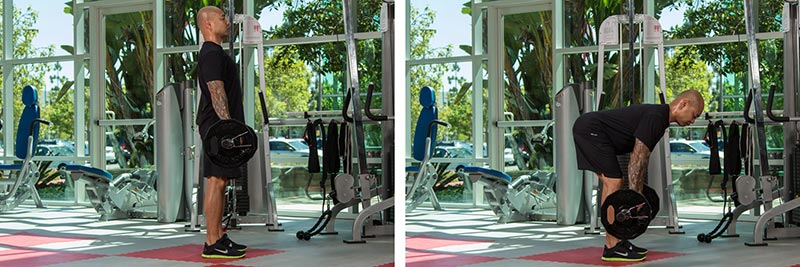
The RDL involves hip flexion and extension while holding a resistance in front of the body. Proper form means the knees are slightly flexed while the spine remains long and straight throughout the range of motion. The movement should be from the hips, not the lumbar spine, and when done properly can strengthen the glutes, hamstring and adductor muscles responsible for extending the hip. Like the squat or deadlift, the RDL uses the stabilizing muscles of the core, which means you'll be working on a flat stomach while developing noticeable, well-defined glutes.
Chin-ups or Pull-ups
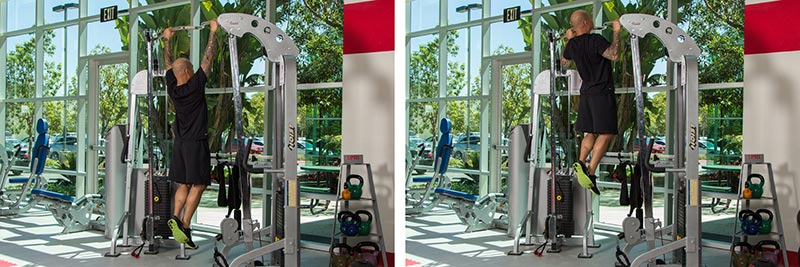
Whether in the gym or outside in a park almost nothing feels more primal than grabbing on to a pull-up bar and knocking out a few reps. The primary difference between a chin-up and a pull-up is hand position; the hands are palms-up during a chip-up and palms down during a pull-up. A palms-up position uses more of the biceps and places less strain on the elbow; it also puts the shoulder in an externally rotated position, which counteracts the effects of being at a computer all day. Either way, chin-ups or pull-ups with your own bodyweight (even if modified) are a great way to strengthen the upper back and give you an overall more muscular appearance.
Bent-over Barbell Rows

In his research on the spine, Canadian professor Stuart McGill, Ph.D., noted that in addition to strengthening the muscles of the upper back, the barbell bent-over row develops important core strength to enhance spinal stability. The bent-over row can improve strength and definition of the back, while also strengthening the deep core muscles that can help give the appearance of a flatter stomach.
Standing Military Press With Dumbbells
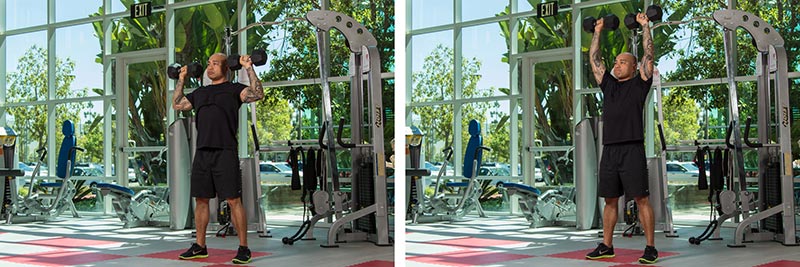
The shoulders sit on top of the spine, which sits on top of the hips. While seated shoulder presses are effective for developing shoulder strength they do not engage the hip and core muscles (and remember using more muscles = burning more calories). Standing shoulder presses require a solid, stable platform using the hips and deep stabilizers of the spine, making this exercise effective at developing core strength while improving the size and definition of the shoulder muscles.
Push-up

Good old-fashioned push-ups can be the most effective way to strengthen your chest and require no equipment. While your body is lying on a bench during a chest press, push-ups require the hip and core muscles to create the stability for the shoulders and arms to move through a complete range of motion, making it another exercise that does multiple things at once. While you can lift more weight lying on a bench or sitting in a machine, neither will use the muscles that help flatten your abs like the push-up does. The good news is that when performed to fatigue, push-ups can initiate a hormonal response that leads to muscle growth, meaning that you don't need to risk injury with a ton of weight to increase mass and definition.
Medicine Ball Low-to-high PNF Lifting Pattern

A PNF pattern means a diagonal movement through multiple planes of motion. A low-to-high medicine ball PNF lifting pattern teaches you how to integrate leg, hip, trunk and arm strength into one system capable of generating a lot of force (strength). If you have relatives who live on a farm you know how strong a person can get from manual labor like swinging an ax or using a shovel, both of which require diagonal movement patterns for success. A major benefit of this exercise is that the external oblique is the largest core muscle and a PNF lifting pattern uses it much more effectively than simply lying on your back and rolling to one side.
Side Planks
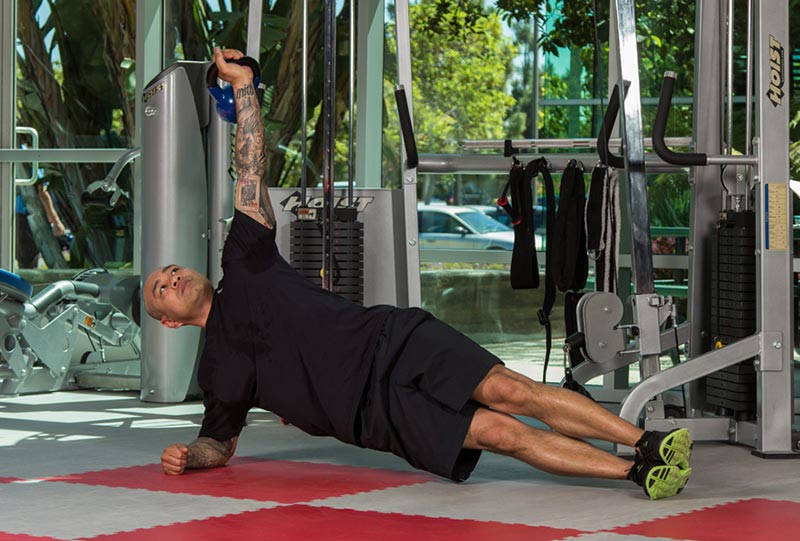
A number of the exercises on this list use the deep core stabilizers as an integral part of the movement, so it is not necessary to do a standard plank. Side planks, however, provide many of the same benefits as a traditional plank but balancing on one arm requires more strength from the shoulder. In addition, the side plank engages both the internal and external obliques, which, when strengthened together, can create a stronger mid-section.
Speed, Agility and Quickness (SAQ) Drills
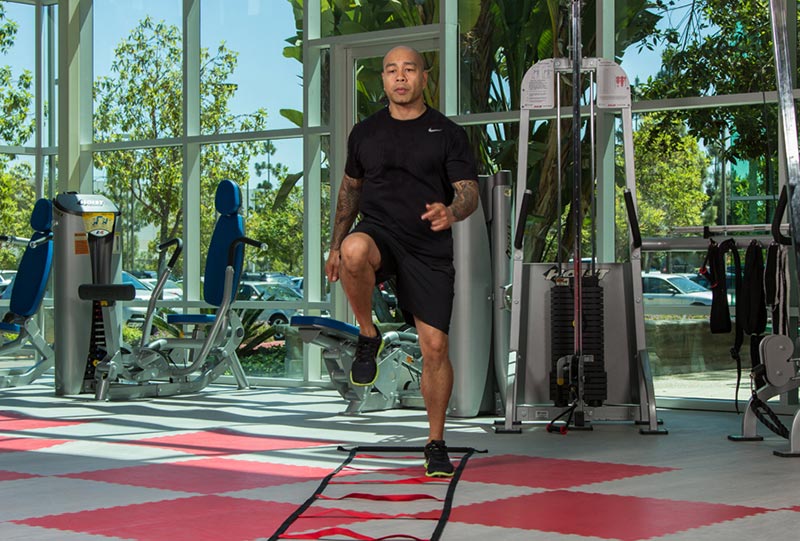
Let's face it, jogging is not that exciting unless you live near a beach with a running path or an outdoor trail with a killer view. Running in a straight line at a steady pace uses only a few of the many leg muscles. On the other hand, doing multidirectional drills for agility, acceleration and reactivity uses all of the lower-body muscles, leaving you with legs like a soccer, lacrosse or rugby player (ask your significant other how they'd like that). SAQ drills improve muscle elasticity, coordination and dynamic balance, and learning different running patterns or reacting to an opponent's movements helps develop new brain neurons. Finally, what would you rather talk about at the next barbecue? "Yeah, I ran three miles in a straight line (yawn)." Or "I was doing the same SAQ drills as Marshawn Lynch." Your choice.
Yoga
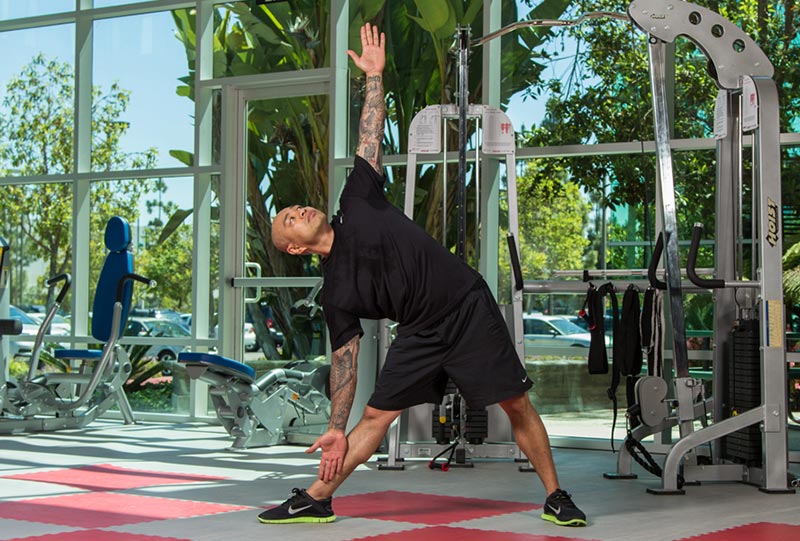






0 comments:
Post a Comment